C.R. Langille's Blog, page 18
August 10, 2014
Standing By
Sorry for the delay folks, but I've been busy helping my wife take care of our new baby girl! I'll get back to blogging as soon as possible. But while you're waiting, please stop by and vote for what you'd like to see in my bonus post on survival. I'll pick the top three voted items and give you my take on the subjects. You can vote here.
Published on August 10, 2014 10:11
July 16, 2014
Survival Mini-Series: The Will to Survive
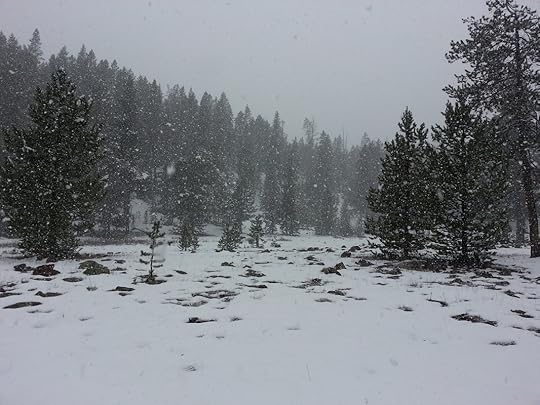 First off, thanks for hanging in there and being patient while life took over. I know it’s been a long time since I last posted, and I apologize. I saved this topic for last, because I think it’s one of the most important aspects to surviving a bad situation. Without the will to survive/live, the rest of your plan or training won’t amount to jack or shit. In this post, I’ll talk about what the will to survive is, how to foster a healthy mental attitude to grow your own will to survive, and share some stories that are good examples of this phenomenon.
First off, thanks for hanging in there and being patient while life took over. I know it’s been a long time since I last posted, and I apologize. I saved this topic for last, because I think it’s one of the most important aspects to surviving a bad situation. Without the will to survive/live, the rest of your plan or training won’t amount to jack or shit. In this post, I’ll talk about what the will to survive is, how to foster a healthy mental attitude to grow your own will to survive, and share some stories that are good examples of this phenomenon.According to Dr. Lawrence Wilson, “The will to survive is the will to stay in one’s body and keep the body healthy and alive.” In other words, it’s the mental strength to endure despite tough odds and crap situations. It’s this will to keep on living that will help get you through the survival situation. You have to have a reason to keep on keepin’ on, or else you’ll give up, and then it’s game over.
There was an entire module of training in my Air Force survival on this very topic. Plus in the survival manual they hand out to flyers deploying to a hostile environment, there is a section dedicated to it as well. It’s a real thing, and there are steps you can take to help strengthen your own will to survive.
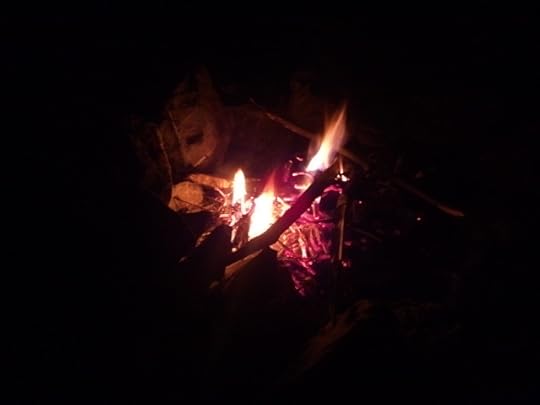 First and foremost, know that the will to survive is a mental muscle that ties in with physical conditions (it can also tie into spiritual factors if you are religious/spiritual). There are certain things you can do to help prepare and exercise this mental muscle, like prepare. Remember the Boy Scout motto of be prepared? You have to know your own limitations before you find yourself in a survival situation, and the best way to find those limitations, are to practice, exercise, and implement. You need to practice survival techniques. I’ve mentioned this before in other posts, but if you only rely on theory, you’re going to be hurting when it comes to time to try it for real. Practice building primitive shelters. Practice building fires with different materials in different weather patterns. Gathering and purifying water, or foraging for food. These are skills that you will need to survive, and if you know deep down that you can rely on your own skills to procure and produce these things, it will take some of the stress off and give you the confidence you need to make it out there mentally.
First and foremost, know that the will to survive is a mental muscle that ties in with physical conditions (it can also tie into spiritual factors if you are religious/spiritual). There are certain things you can do to help prepare and exercise this mental muscle, like prepare. Remember the Boy Scout motto of be prepared? You have to know your own limitations before you find yourself in a survival situation, and the best way to find those limitations, are to practice, exercise, and implement. You need to practice survival techniques. I’ve mentioned this before in other posts, but if you only rely on theory, you’re going to be hurting when it comes to time to try it for real. Practice building primitive shelters. Practice building fires with different materials in different weather patterns. Gathering and purifying water, or foraging for food. These are skills that you will need to survive, and if you know deep down that you can rely on your own skills to procure and produce these things, it will take some of the stress off and give you the confidence you need to make it out there mentally. The next part is exercise. You do not want to be in poor health when you find yourself in a survival situation. It’s only going to get worse as the days go on, and if you aren’t in the good health beforehand, it’s going to make things tougher. That stress and hurt is going to wear on you physically. Once the physical stress sets in, it starts eating away at your mental strength and keeping that will to survive gets harder to maintain. So eat right and exercise, and it will pay dividends if you find yourself in the suck.
 The final part of this equation is implementation. Having a strong will to survive is an active process. While the first two steps are physical factors that feed into the will to survive, this step is all mental. If you find yourself in a bad situation and you have to survive, there are things you have to actively do to keep your mental strength where it needs to be. You need to focus on the reasons you have to stay alive. While all of these may not apply, hopefully you can find one or two that work. Focus on your family, friends, loved ones, your faith in a higher power (if you are spiritual/religious), or even get stubborn and get to the point that you won’t let Mother Nature kill you. Heck, maybe your will to survive is fed by fears that your family and friends will find your stash of porn on your computer. Maybe you have dogs at home that need you to survive and you’re their only hope. Perhaps you just need to see the results of the next World Cup before you pass on. Whatever it is that keeps you wanting to live, grab a hold of it and don’t let go. Keep that idea in the forefront of your mind and don’t let it waver. If you with others, you all need to work together to keep one another up and willing to fight on.
The final part of this equation is implementation. Having a strong will to survive is an active process. While the first two steps are physical factors that feed into the will to survive, this step is all mental. If you find yourself in a bad situation and you have to survive, there are things you have to actively do to keep your mental strength where it needs to be. You need to focus on the reasons you have to stay alive. While all of these may not apply, hopefully you can find one or two that work. Focus on your family, friends, loved ones, your faith in a higher power (if you are spiritual/religious), or even get stubborn and get to the point that you won’t let Mother Nature kill you. Heck, maybe your will to survive is fed by fears that your family and friends will find your stash of porn on your computer. Maybe you have dogs at home that need you to survive and you’re their only hope. Perhaps you just need to see the results of the next World Cup before you pass on. Whatever it is that keeps you wanting to live, grab a hold of it and don’t let go. Keep that idea in the forefront of your mind and don’t let it waver. If you with others, you all need to work together to keep one another up and willing to fight on.It’s going to suck. Survival isn’t fun. If you’re having fun surviving, then you’re camping. So you need to do everything humanly possible to endure that suck. Because once the will to survive goes, it doesn’t matter if you have a freshwater natural spring and a pizza joint right next to your survival location, you won’t make it. I’ve started watching television program called Naked and Afraid. It puts two survival experts together in a harsh environment without any clothes and only one survival tool apiece to help them. The pair then has to survive for 21 days. It becomes obvious when the participants lose their will to survive. They become depressed, they panic, and they usually end up tapping out and going home.
An amazing story of survival goes to hiker, Aron Ralston who fell down a slot canyon in eastern Utah and got his arm trapped by a heavy boulder. Ralston spent five days pinned by the boulder until he decided that he needed to initiate his own rescue. Through an incredible will to survive, Ralston used a pocketknife to cut his own trapped arm off at the elbow and hike out to safety.
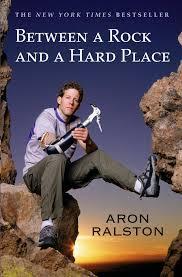 Another amazing story of survival is the story of Steven Callahan. In 1982 Callahan set sail alone in a sailboat from the Canary Islands. During a bad storm, his boat sank and he found himself having to survive in a small inflatable life raft. Most of his supplies were gone, and he spent 76 days adrift in the Caribbean. He survived by keeping his mind occupied. Callahan divided his mind into two people, a captain and a crewmember, and accounts from his logbook show the two personalities. It kept him mentally alive and willing to survive.
Another amazing story of survival is the story of Steven Callahan. In 1982 Callahan set sail alone in a sailboat from the Canary Islands. During a bad storm, his boat sank and he found himself having to survive in a small inflatable life raft. Most of his supplies were gone, and he spent 76 days adrift in the Caribbean. He survived by keeping his mind occupied. Callahan divided his mind into two people, a captain and a crewmember, and accounts from his logbook show the two personalities. It kept him mentally alive and willing to survive. 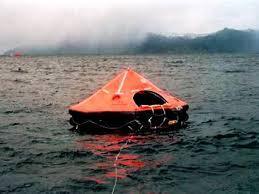 So how does this apply to writing? Simple, it’s this aspect of survival that you can really get deep into a character’s POV and let it shine. This will turn your reactive character into an active character that people can connect with. Focus on their will to survive and show the reader why they want to live. What’s driving their will to keep on fighting? Is it family? Vengeance perhaps? Who knows, but take the opportunity to show off some mad characterizations skills.
So how does this apply to writing? Simple, it’s this aspect of survival that you can really get deep into a character’s POV and let it shine. This will turn your reactive character into an active character that people can connect with. Focus on their will to survive and show the reader why they want to live. What’s driving their will to keep on fighting? Is it family? Vengeance perhaps? Who knows, but take the opportunity to show off some mad characterizations skills.Don’t forget to vote on what you want me to cover in the bonus blog post. You can vote here! I’ll pick the top three topics and share some wisdom. If you don’t see a topic listed in the poll, go ahead and vote other and shoot me a message on what you’d like to know about.
Published on July 16, 2014 09:28
April 17, 2014
Guest Post
If you'd like to guest post on my website, drop me a line. I'd be more than happy to share your views of writing, horror, survival, or gaming.
Published on April 17, 2014 09:18
Survival Mini-Series: Food & Water
It’s been awhile, but I haven’t forgotten about the survival mini-series. Last time I talked to you about shelters. This time, we’re going deeper into survival and looking at food and water procurement. Shelter is very important for surviving in the wilds, but without food and water, it doesn’t mean anything. I found a lot of this information on the Internet and have provided links to some of the articles. Other information comes from my own Air Force survival instruction and knowledge. Let’s talk about food first.
According to Dr. Alan D. Lieberson, a doctor who wrote an article for Scientific American, “The duration of survival without food is greatly influenced by factors such as body weight, genetic variation, other health considerations, and most importantly, the presence or absence of dehydration.” After doing some of my own research, I found a variable of about 10-30 days, but as Dr. Lieberson pointed out, it depends on each individual. While researching this very topic, I found a helpful little saying that brings it into perspective: Three minutes without air, three days without water, and three weeks without food. In any case, we need food to continue to thrive.
When you start to starve, the body’s metabolism slows down and feelings of fatigue and a drop in mental acuity occur. Simple motor skills begin to shut down, hormone production is disrupted, and your will to survive goes away. As time goes on, the body begins to consume itself to survive which can lead to weight loss (the bad kind), organ damage, and eventually death. Therefore, food is absolutely necessary for continued survival. It doesn’t end there though, knowing what to eat and how to procure it can also be the difference between life and death.
When it comes to surviving, you always have to play a game of risk management. Ask yourself, do the risks outweigh the gains? If so, maybe you might want to rethink your plan. In a long-term survival situation, calories count, so you don’t want to expend a lot of energy if you don’t have to. Hunting sounds great, but it may take a lot more energy than it’s worth; maybe climbing a tree for nuts isn’t worth the risk of injury. I’m not saying hunting game or climbing trees is out of the picture, I’m merely stating that you need to examine all the possibilities and come to an educated conclusion that fits your situation.
As far as food goes, I’ll break it down to three areas: plants, insects, animals. Let’s take a look at the first area, plants. Plants are by far the easiest and possibly the most plentiful source of food you can find in the wild (depending on the area). However, plants can be just as dangerous as anything else, and I can’t stress enough the following fact: DO NOT EAT ANY PLANTS UNLESS YOU CAN POSITIVELY IDENTIFY WHAT YOU ARE EATING. There are some plants out there that are very toxic to humans, and they will make you sick or even kill you. There is an edibility test; however, it is time consuming and still contains risk. The best course of action is to educate yourself beforehand and know what plants are in the area you are traveling through. If you know before you go, you’ll have an idea what you can eat. I can’t stress this enough, you need to be educated on the types of local plants in your area because there are some poisonous look-alikes for safe plants, and unless you know what you are looking for, it could end up making a bad situation worse.
Here are some warning signs of plants to avoid: thorns, shiny leaves, white/yellow berries, milky sap, bitter tastes, plants with leaves in groups of three, fine hairs, and plants with an almond scent. While this isn’t comprehensive, and there are some exceptions to this rule, it’s a good start. Mushrooms are a whole other beast, but follow the same rules, unless you know for a FACT that they are safe, don’t risk eating them.
Here are some known goods that are easily identifiable. Cattails or punks are found near the edges of water sources. They have long stocks and brown “hot-dog” looking part at the top. Many parts of the plant are edible to include the brown part can be eaten in the earlier part of development. The roots can be boiled or eaten raw, as well as the stock and the leaves.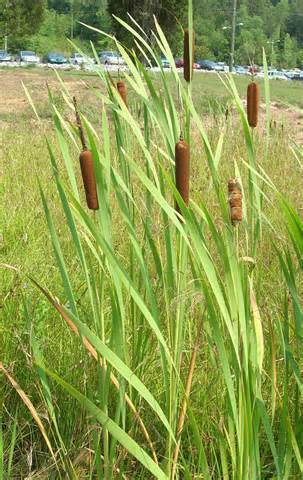 Clovers are another plant that are edible. They can be eaten raw or boiled. Avoid eating these while pregnant.
Clovers are another plant that are edible. They can be eaten raw or boiled. Avoid eating these while pregnant.
 Dandelions are abundant and can be eaten. The entire plant is edible, although don’t eat the seeds. Also, eat the leaves before they mature otherwise you’ll have to boil them to avoid a bitter taste.
Dandelions are abundant and can be eaten. The entire plant is edible, although don’t eat the seeds. Also, eat the leaves before they mature otherwise you’ll have to boil them to avoid a bitter taste.
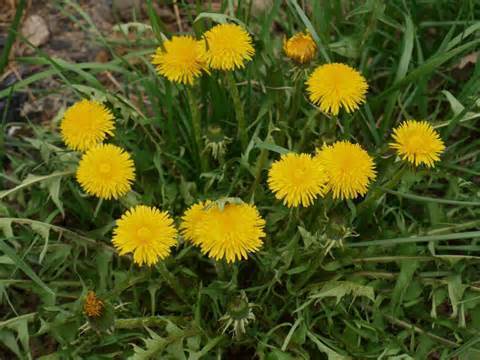 If you live in an arid or desert climate, the prickly pear cactus can be eaten. Just be sure to remove the spines.
If you live in an arid or desert climate, the prickly pear cactus can be eaten. Just be sure to remove the spines.
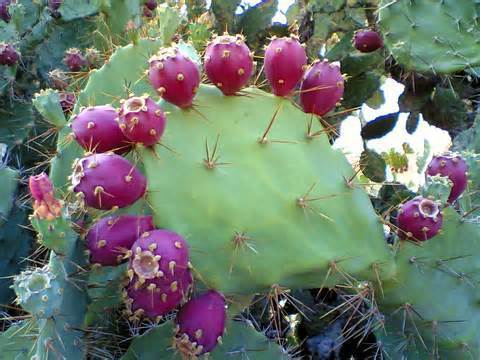 The art of foraging plants is extensive and could take an entire book to cover. However, nothing beats hands on training. If there is a class in your area on foraging or identifying edible plants, take it. It could save your life one day. For now, we’re going to move on to insects.
The art of foraging plants is extensive and could take an entire book to cover. However, nothing beats hands on training. If there is a class in your area on foraging or identifying edible plants, take it. It could save your life one day. For now, we’re going to move on to insects.
Insects are easy to find and can be highly nutritious. Many cultures survive on a diet of insects and plant all around the world, and if you can get over food aversions, you can also survive on this plentiful bounty. Much like plants though, you have to know what you are eating or you could get stung or poisoned.
When searching for insects, look under rocks, logs, leaves, loose bark or under the dirt. Grasshoppers, crickets, ants, grubs, worms and larvae can be eaten. While most can be eaten raw, some are easier to eat after being cooked. During my training, one of my instructors said if it was much more than an inch long, cook it. Better safe than sorry, especially when it comes to aquatic insects. Avoid insects that are covered in fuzz, brightly colored, slow-moving in the open, and disease carrying (such as flies, and mosquitos). I’d also avoid stinging and known poisonous insects; while some are safe to eat, the risk of procurement may outweigh the gains. Use your best judgment.
Finally, let’s talk about meat. If you are a vegan or vegetarian, then you might just want to skip this part and go straight to water procurement. In my opinion, nothing beats a hot meal when you’re surviving, and having cooked meat can help take the edge off of a bad situation. However, taking game in the field brings its own set of issues. Whether you trap, fish, or hunt an animal, you’re going to have to prepare it for eating. This generally means gutting, skinning, and cleaning the meat. I’m not going to get in to the methods of hunting, fishing and trapping, because that will be another article. I have provided some links below on the procurement and processing of game animals.
First off, once you’ve killed something, you’re going to want to gut it as soon as possible. This helps cool the meat down to prevent spoilage. When it comes to meat, life begins at 40, or in this case, 40 degrees. Meat will spoil quickly at temps above 40 degrees, so it is vital to keep it cool. Be careful not to rupture the intestines when gutting the animal, this will contaminate the meat. You also want to try and keep the carcass clear of flies if possible. Flies carry disease and can transfer that disease to your meal.
When you cook the meat, you want to make sure it is thoroughly cooked in order to kill any bugs or bacteria that may have called that meat home. A good rule of thumb, is if the meat looks discolored or smells funny, don’t eat it. Hunting can be very rewarding, but it can also be very taxing. You have to weigh the benefits to the calorie loss or risk. Also, if you kill a large animal, smoke the meat or turn it into jerky for long term use. A survival situation is the last place you want to be wasteful. Besides, you just killed that animal so you could survive, treat it with respect and use everything you can from its death.
The next step of surviving is water procurement. Without water, you could die within three days. The body needs water to survive, and a lot of other functions depend on that water intake to function, to include eating. Don’t eat anything if you don’t have water. It takes water to digest food properly, and you could speed up the dehydration process by eating without water intake.
Much like food, many factors go into figuring out how much water you need on a daily basis and how long you could actually survive without it. However, a good rule of thumb is that a person needs a gallon of water per day for intake and sanitation needs. Of course, you could get away with less, and probably will have to get away with less in a survival situation. External factors can play a big part in this as well; if it is extremely hot, or you are burning a lot of calories, then you’ll need more water.
Dehydration can lead to heat exhaustion or heat stroke, swelling of the brain, seizures, low blood volume shock, kidney failure, and of course, death. Much like starvation, motor skills will slow or cease, headaches will occur, and the body will begin to shut down. There’s no good gauge for dehydration because everyone is different. If you’re feeling thirsty, you’re already dehydrated. The best bet is to watch the color of your urine. You want your urine to be a clear as possible; dark or yellow urine is a sign that you need more water. To re-hydrate, drink water and try to replace electrolytes if possible. Drinking water alone sometimes isn’t enough, and drinking too much water can be just as dangerous. Electrolytes are the key here. It pays dividends to have an electrolyte powder mix in your survival kit. If you don’t have that, there are many natural recipes that can replace the lost electrolytes. Do some research on what natural herbs and wild veggies grow in your area and know how to make them into a tea or broth.
There are a number of ways to finding water in the wild. Of course, the finding a lake, stream, or pond is the easiest, but also require purification before consumption. Even if the river or stream is fast moving, don’t trust it. You don’t know what’s been in the water upstream, or what kind of bacteria lives in the water. When surviving, a debilitating stomach bug is the last thing you want to deal with.
To purify water, boiling is your best method. Put the water in a metal container if possible, and boil for at least ten minutes. This will kill any of the bugs and bacteria in the water and render it safe to drink. If you can’t boil it, there are other methods such as: water purification tablets, iodine drops, or filtration. I've provided some links below on how some of these methods work, and it’s worth a look. Be prepared and take purification tablets and at least one other method of purification with you whenever you go out into the wild. They make some small filters now that are built into a straw that you can use on the go. A tiny thing like that can life or death.
Now, on to the hard part, what if you are in an area that doesn't have a stream or other open water source? Don’t worry; there are methods of collecting water that you can still utilize to save your life. I’ll explain a couple of these methods, but remember that when it comes to survival, sometimes you think outside the box.
The first method is simply collecting the morning dew off the tall grass or plants. Wrap clothing or a towel around your legs and walk through the tall vegetation in the early morning. The dew will saturate the cloth, which you can then wring out and drink. I wouldn't recommend this method if you think the area has been sprayed with a pesticide though; it will make the water off the plants undrinkable.
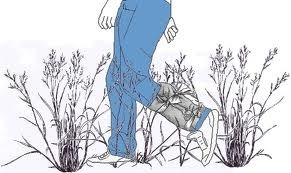 The next method is a condensation or transpiration bag. I always pack a couple heavy duty plastic sacks with me when I go camping or hunting. You can take the bag and put it on a tree or bush with green vegetation. Let it sit in the sun for a few hours, and you’ll notice condensation collecting in the bag and pooling at the bottom of the bag. This method takes a while, but if you put a few bags out, it can provide you with enough water to keep you alive.
The next method is a condensation or transpiration bag. I always pack a couple heavy duty plastic sacks with me when I go camping or hunting. You can take the bag and put it on a tree or bush with green vegetation. Let it sit in the sun for a few hours, and you’ll notice condensation collecting in the bag and pooling at the bottom of the bag. This method takes a while, but if you put a few bags out, it can provide you with enough water to keep you alive.
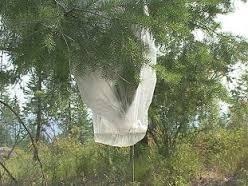 The next method is referred to as a solar still. Dig a hole about 12 inches deep by 12 inches wide. You’ll need a sheet of plastic (again, a good reason to carry plastic sacks). Put a container centered at the bottom of the hole and then surround the container with green vegetation, and then cover the hole with plastics. Use rocks or something heavy to keep the plastic from falling in, and then place a couple of small stones at the center of the plastic sheet to weigh it down slightly. This method won’t produce much water, but some water is better than no water; plus, the water it produces is pure and will not need to be purified. Plus, as the method implies, it distills water, so it can be used near the ocean and will still produce drinkable water.
The next method is referred to as a solar still. Dig a hole about 12 inches deep by 12 inches wide. You’ll need a sheet of plastic (again, a good reason to carry plastic sacks). Put a container centered at the bottom of the hole and then surround the container with green vegetation, and then cover the hole with plastics. Use rocks or something heavy to keep the plastic from falling in, and then place a couple of small stones at the center of the plastic sheet to weigh it down slightly. This method won’t produce much water, but some water is better than no water; plus, the water it produces is pure and will not need to be purified. Plus, as the method implies, it distills water, so it can be used near the ocean and will still produce drinkable water.
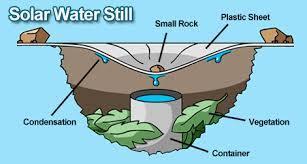 Hopefully this post provided you with some good information. It’s always a good idea to be prepared; take food and water with you when you go camping, hiking, or hunting. Have multiple methods of purifying water. Try and be in the best health you can be to make surviving easier. Most of all get educated and trained; I’ve said it before and needs to be repeated, but you have to try these methods out before the shit hits the fan. When you are actually surviving isn’t the time to be trying new things when you could have learned how to properly do those things in a controlled environment.
Hopefully this post provided you with some good information. It’s always a good idea to be prepared; take food and water with you when you go camping, hiking, or hunting. Have multiple methods of purifying water. Try and be in the best health you can be to make surviving easier. Most of all get educated and trained; I’ve said it before and needs to be repeated, but you have to try these methods out before the shit hits the fan. When you are actually surviving isn’t the time to be trying new things when you could have learned how to properly do those things in a controlled environment.
Coming up next, The Will to Survive. Also, don’t forget to vote on what you want me to cover in the bonus blog post. You can vote here! I’ll pick the top three topics and share some wisdom. If you don’t see a topic listed in the poll, go ahead and vote other and shoot me a message on what you’d like to know about.
Dr. Lieberson’s Article:
http://www.scientificamerican.com/article/how-long-can-a-person-sur/
Edibility Test:
http://www.wilderness-survival.net/plants-1.php#uet
http://adventure.howstuffworks.com/universal-edibility-test.htm
Plants:
http://www.artofmanliness.com/2010/10/06/surviving-in-the-wild-19-common-edible-plants/
Insects:
http://www.fieldandstream.com/articles/survival/survival-food/2010/08/eating-insects-survival
http://survival.outdoorlife.com/blogs/survivalist/2012/11/survival-skills-5-bugs-you-want-eat
Animals:
http://www.wilderness-survival.net/food-1.php
http://www.wilderness-survival.net/food-5.php
Water:
http://www.wilderness-survival.net/water-1.php
http://www.princeton.edu/~oa/manual/water.shtml
According to Dr. Alan D. Lieberson, a doctor who wrote an article for Scientific American, “The duration of survival without food is greatly influenced by factors such as body weight, genetic variation, other health considerations, and most importantly, the presence or absence of dehydration.” After doing some of my own research, I found a variable of about 10-30 days, but as Dr. Lieberson pointed out, it depends on each individual. While researching this very topic, I found a helpful little saying that brings it into perspective: Three minutes without air, three days without water, and three weeks without food. In any case, we need food to continue to thrive.
When you start to starve, the body’s metabolism slows down and feelings of fatigue and a drop in mental acuity occur. Simple motor skills begin to shut down, hormone production is disrupted, and your will to survive goes away. As time goes on, the body begins to consume itself to survive which can lead to weight loss (the bad kind), organ damage, and eventually death. Therefore, food is absolutely necessary for continued survival. It doesn’t end there though, knowing what to eat and how to procure it can also be the difference between life and death.
When it comes to surviving, you always have to play a game of risk management. Ask yourself, do the risks outweigh the gains? If so, maybe you might want to rethink your plan. In a long-term survival situation, calories count, so you don’t want to expend a lot of energy if you don’t have to. Hunting sounds great, but it may take a lot more energy than it’s worth; maybe climbing a tree for nuts isn’t worth the risk of injury. I’m not saying hunting game or climbing trees is out of the picture, I’m merely stating that you need to examine all the possibilities and come to an educated conclusion that fits your situation.
As far as food goes, I’ll break it down to three areas: plants, insects, animals. Let’s take a look at the first area, plants. Plants are by far the easiest and possibly the most plentiful source of food you can find in the wild (depending on the area). However, plants can be just as dangerous as anything else, and I can’t stress enough the following fact: DO NOT EAT ANY PLANTS UNLESS YOU CAN POSITIVELY IDENTIFY WHAT YOU ARE EATING. There are some plants out there that are very toxic to humans, and they will make you sick or even kill you. There is an edibility test; however, it is time consuming and still contains risk. The best course of action is to educate yourself beforehand and know what plants are in the area you are traveling through. If you know before you go, you’ll have an idea what you can eat. I can’t stress this enough, you need to be educated on the types of local plants in your area because there are some poisonous look-alikes for safe plants, and unless you know what you are looking for, it could end up making a bad situation worse.
Here are some warning signs of plants to avoid: thorns, shiny leaves, white/yellow berries, milky sap, bitter tastes, plants with leaves in groups of three, fine hairs, and plants with an almond scent. While this isn’t comprehensive, and there are some exceptions to this rule, it’s a good start. Mushrooms are a whole other beast, but follow the same rules, unless you know for a FACT that they are safe, don’t risk eating them.
Here are some known goods that are easily identifiable. Cattails or punks are found near the edges of water sources. They have long stocks and brown “hot-dog” looking part at the top. Many parts of the plant are edible to include the brown part can be eaten in the earlier part of development. The roots can be boiled or eaten raw, as well as the stock and the leaves.
 Clovers are another plant that are edible. They can be eaten raw or boiled. Avoid eating these while pregnant.
Clovers are another plant that are edible. They can be eaten raw or boiled. Avoid eating these while pregnant. Dandelions are abundant and can be eaten. The entire plant is edible, although don’t eat the seeds. Also, eat the leaves before they mature otherwise you’ll have to boil them to avoid a bitter taste.
Dandelions are abundant and can be eaten. The entire plant is edible, although don’t eat the seeds. Also, eat the leaves before they mature otherwise you’ll have to boil them to avoid a bitter taste. If you live in an arid or desert climate, the prickly pear cactus can be eaten. Just be sure to remove the spines.
If you live in an arid or desert climate, the prickly pear cactus can be eaten. Just be sure to remove the spines. The art of foraging plants is extensive and could take an entire book to cover. However, nothing beats hands on training. If there is a class in your area on foraging or identifying edible plants, take it. It could save your life one day. For now, we’re going to move on to insects.
The art of foraging plants is extensive and could take an entire book to cover. However, nothing beats hands on training. If there is a class in your area on foraging or identifying edible plants, take it. It could save your life one day. For now, we’re going to move on to insects.Insects are easy to find and can be highly nutritious. Many cultures survive on a diet of insects and plant all around the world, and if you can get over food aversions, you can also survive on this plentiful bounty. Much like plants though, you have to know what you are eating or you could get stung or poisoned.
When searching for insects, look under rocks, logs, leaves, loose bark or under the dirt. Grasshoppers, crickets, ants, grubs, worms and larvae can be eaten. While most can be eaten raw, some are easier to eat after being cooked. During my training, one of my instructors said if it was much more than an inch long, cook it. Better safe than sorry, especially when it comes to aquatic insects. Avoid insects that are covered in fuzz, brightly colored, slow-moving in the open, and disease carrying (such as flies, and mosquitos). I’d also avoid stinging and known poisonous insects; while some are safe to eat, the risk of procurement may outweigh the gains. Use your best judgment.
Finally, let’s talk about meat. If you are a vegan or vegetarian, then you might just want to skip this part and go straight to water procurement. In my opinion, nothing beats a hot meal when you’re surviving, and having cooked meat can help take the edge off of a bad situation. However, taking game in the field brings its own set of issues. Whether you trap, fish, or hunt an animal, you’re going to have to prepare it for eating. This generally means gutting, skinning, and cleaning the meat. I’m not going to get in to the methods of hunting, fishing and trapping, because that will be another article. I have provided some links below on the procurement and processing of game animals.
First off, once you’ve killed something, you’re going to want to gut it as soon as possible. This helps cool the meat down to prevent spoilage. When it comes to meat, life begins at 40, or in this case, 40 degrees. Meat will spoil quickly at temps above 40 degrees, so it is vital to keep it cool. Be careful not to rupture the intestines when gutting the animal, this will contaminate the meat. You also want to try and keep the carcass clear of flies if possible. Flies carry disease and can transfer that disease to your meal.
When you cook the meat, you want to make sure it is thoroughly cooked in order to kill any bugs or bacteria that may have called that meat home. A good rule of thumb, is if the meat looks discolored or smells funny, don’t eat it. Hunting can be very rewarding, but it can also be very taxing. You have to weigh the benefits to the calorie loss or risk. Also, if you kill a large animal, smoke the meat or turn it into jerky for long term use. A survival situation is the last place you want to be wasteful. Besides, you just killed that animal so you could survive, treat it with respect and use everything you can from its death.
The next step of surviving is water procurement. Without water, you could die within three days. The body needs water to survive, and a lot of other functions depend on that water intake to function, to include eating. Don’t eat anything if you don’t have water. It takes water to digest food properly, and you could speed up the dehydration process by eating without water intake.
Much like food, many factors go into figuring out how much water you need on a daily basis and how long you could actually survive without it. However, a good rule of thumb is that a person needs a gallon of water per day for intake and sanitation needs. Of course, you could get away with less, and probably will have to get away with less in a survival situation. External factors can play a big part in this as well; if it is extremely hot, or you are burning a lot of calories, then you’ll need more water.
Dehydration can lead to heat exhaustion or heat stroke, swelling of the brain, seizures, low blood volume shock, kidney failure, and of course, death. Much like starvation, motor skills will slow or cease, headaches will occur, and the body will begin to shut down. There’s no good gauge for dehydration because everyone is different. If you’re feeling thirsty, you’re already dehydrated. The best bet is to watch the color of your urine. You want your urine to be a clear as possible; dark or yellow urine is a sign that you need more water. To re-hydrate, drink water and try to replace electrolytes if possible. Drinking water alone sometimes isn’t enough, and drinking too much water can be just as dangerous. Electrolytes are the key here. It pays dividends to have an electrolyte powder mix in your survival kit. If you don’t have that, there are many natural recipes that can replace the lost electrolytes. Do some research on what natural herbs and wild veggies grow in your area and know how to make them into a tea or broth.
There are a number of ways to finding water in the wild. Of course, the finding a lake, stream, or pond is the easiest, but also require purification before consumption. Even if the river or stream is fast moving, don’t trust it. You don’t know what’s been in the water upstream, or what kind of bacteria lives in the water. When surviving, a debilitating stomach bug is the last thing you want to deal with.
To purify water, boiling is your best method. Put the water in a metal container if possible, and boil for at least ten minutes. This will kill any of the bugs and bacteria in the water and render it safe to drink. If you can’t boil it, there are other methods such as: water purification tablets, iodine drops, or filtration. I've provided some links below on how some of these methods work, and it’s worth a look. Be prepared and take purification tablets and at least one other method of purification with you whenever you go out into the wild. They make some small filters now that are built into a straw that you can use on the go. A tiny thing like that can life or death.
Now, on to the hard part, what if you are in an area that doesn't have a stream or other open water source? Don’t worry; there are methods of collecting water that you can still utilize to save your life. I’ll explain a couple of these methods, but remember that when it comes to survival, sometimes you think outside the box.
The first method is simply collecting the morning dew off the tall grass or plants. Wrap clothing or a towel around your legs and walk through the tall vegetation in the early morning. The dew will saturate the cloth, which you can then wring out and drink. I wouldn't recommend this method if you think the area has been sprayed with a pesticide though; it will make the water off the plants undrinkable.
 The next method is a condensation or transpiration bag. I always pack a couple heavy duty plastic sacks with me when I go camping or hunting. You can take the bag and put it on a tree or bush with green vegetation. Let it sit in the sun for a few hours, and you’ll notice condensation collecting in the bag and pooling at the bottom of the bag. This method takes a while, but if you put a few bags out, it can provide you with enough water to keep you alive.
The next method is a condensation or transpiration bag. I always pack a couple heavy duty plastic sacks with me when I go camping or hunting. You can take the bag and put it on a tree or bush with green vegetation. Let it sit in the sun for a few hours, and you’ll notice condensation collecting in the bag and pooling at the bottom of the bag. This method takes a while, but if you put a few bags out, it can provide you with enough water to keep you alive. The next method is referred to as a solar still. Dig a hole about 12 inches deep by 12 inches wide. You’ll need a sheet of plastic (again, a good reason to carry plastic sacks). Put a container centered at the bottom of the hole and then surround the container with green vegetation, and then cover the hole with plastics. Use rocks or something heavy to keep the plastic from falling in, and then place a couple of small stones at the center of the plastic sheet to weigh it down slightly. This method won’t produce much water, but some water is better than no water; plus, the water it produces is pure and will not need to be purified. Plus, as the method implies, it distills water, so it can be used near the ocean and will still produce drinkable water.
The next method is referred to as a solar still. Dig a hole about 12 inches deep by 12 inches wide. You’ll need a sheet of plastic (again, a good reason to carry plastic sacks). Put a container centered at the bottom of the hole and then surround the container with green vegetation, and then cover the hole with plastics. Use rocks or something heavy to keep the plastic from falling in, and then place a couple of small stones at the center of the plastic sheet to weigh it down slightly. This method won’t produce much water, but some water is better than no water; plus, the water it produces is pure and will not need to be purified. Plus, as the method implies, it distills water, so it can be used near the ocean and will still produce drinkable water. Hopefully this post provided you with some good information. It’s always a good idea to be prepared; take food and water with you when you go camping, hiking, or hunting. Have multiple methods of purifying water. Try and be in the best health you can be to make surviving easier. Most of all get educated and trained; I’ve said it before and needs to be repeated, but you have to try these methods out before the shit hits the fan. When you are actually surviving isn’t the time to be trying new things when you could have learned how to properly do those things in a controlled environment.
Hopefully this post provided you with some good information. It’s always a good idea to be prepared; take food and water with you when you go camping, hiking, or hunting. Have multiple methods of purifying water. Try and be in the best health you can be to make surviving easier. Most of all get educated and trained; I’ve said it before and needs to be repeated, but you have to try these methods out before the shit hits the fan. When you are actually surviving isn’t the time to be trying new things when you could have learned how to properly do those things in a controlled environment.Coming up next, The Will to Survive. Also, don’t forget to vote on what you want me to cover in the bonus blog post. You can vote here! I’ll pick the top three topics and share some wisdom. If you don’t see a topic listed in the poll, go ahead and vote other and shoot me a message on what you’d like to know about.
Dr. Lieberson’s Article:
http://www.scientificamerican.com/article/how-long-can-a-person-sur/
Edibility Test:
http://www.wilderness-survival.net/plants-1.php#uet
http://adventure.howstuffworks.com/universal-edibility-test.htm
Plants:
http://www.artofmanliness.com/2010/10/06/surviving-in-the-wild-19-common-edible-plants/
Insects:
http://www.fieldandstream.com/articles/survival/survival-food/2010/08/eating-insects-survival
http://survival.outdoorlife.com/blogs/survivalist/2012/11/survival-skills-5-bugs-you-want-eat
Animals:
http://www.wilderness-survival.net/food-1.php
http://www.wilderness-survival.net/food-5.php
Water:
http://www.wilderness-survival.net/water-1.php
http://www.princeton.edu/~oa/manual/water.shtml
Published on April 17, 2014 09:15
March 31, 2014
Guest Post!!! Fantasy is Life...with Magic
I'm still working on the next installment of the survival mini-series. Don't fret though, to tide you over, a talented writer and a good friend of mine graced us with some knowledge. Let me introduce Mary DeSantis and her take on the fantasy genre.
So, what is fantasy?
I hear this question asked a lot. Most often, the answer comes among rambling paragraphs about casting spells and riding dragons and defeating evil wizards. Is this wrong? No. Fantasy can be all those things, but I’m not convinced it must be only those things.
When I started my mfa at Seton Hill, I wanted to write a fantasy novel that didn’t have a lot of magic. As an unexperienced writer, I thought this was because I wanted to “break out of the mold” or whatever other saying I had at the time. Now, two and a half years later, I’ve realized that it wasn’t the mold at all. I wanted to write a story with little magic, not because I necessarily didn’t want magic. No, I didn’t want the magic to get in the way of the story or, more importantly, the characters.
While fighting the endless battle of getting a novel to work, I’ve learned so much about the people I’ve chosen to inhabit my world. The villain has fantastic power, and he is really the only one. There are magical swords. My heroine makes use of the power the swords give without realizing it, but at the end of the day, the only thing that she (and, ultimately, the reader) thinks she has in her favor is determination and skill. There’s no blanket of safety in spells. She can’t wave a wand and curse her enemy or call a fire-breathing dragon or give herself super strength. What she can do is fight hard and care even harder.
And yet, the story is still fantasy because it contains some fantastic elements. It contains larger-than-life threats that force impossible odds on my heroine, but she persists. It’s not about what magic can do. It’s not about how she can use magic. It’s about how she fights, using only who she is and what she believes, as weapons. It’s a novel about one person’s struggle, and really, isn’t that what stories are?
“So, what is fantasy?”
For me? Fantasy is a story about people who happen to be surrounded by/have fantastic abilities. When the magic eclipses the struggle, the fantasy has lost its ability to relate to the real world. I read about dragons and wand-waving and magical battles as much as the next fantasy buff, and I love me a good supernatural smackdown any day. But I want characters to grow and change and use who they are, not what they can do, to ultimately emerge victorious.
So what is fantasy? It’s a story about people who are just people facing things that are much larger than them.
Bio
Mary DeSantis, also known as desantism, is an –ism—almost enough said. After spending the first twenty-something years of her life in a small city fifteen miles north of Boston, she up and moved to North Carolina, where she’s resided for about two years. Mary has been an avid Disney lover from age too-young-to-remember and, as a result, writes fantasy, often about royalty and soldiers. When she’s not slaving away in front of her computer, Mary can be found belting Disney songs at the top of her lungs, hanging with her local buddies from Write Club (which she’d discuss, but the first rule of Write Club…), getting lost in a book, or learning to fight fire breathing dragons.
Blog: http://outofthelockbox.blogspot.com/
Twitter: https://www.twitter.com/desantismt
Facebook: https://www.facebook.com/desantismauthor
So, what is fantasy?
I hear this question asked a lot. Most often, the answer comes among rambling paragraphs about casting spells and riding dragons and defeating evil wizards. Is this wrong? No. Fantasy can be all those things, but I’m not convinced it must be only those things.
When I started my mfa at Seton Hill, I wanted to write a fantasy novel that didn’t have a lot of magic. As an unexperienced writer, I thought this was because I wanted to “break out of the mold” or whatever other saying I had at the time. Now, two and a half years later, I’ve realized that it wasn’t the mold at all. I wanted to write a story with little magic, not because I necessarily didn’t want magic. No, I didn’t want the magic to get in the way of the story or, more importantly, the characters.
While fighting the endless battle of getting a novel to work, I’ve learned so much about the people I’ve chosen to inhabit my world. The villain has fantastic power, and he is really the only one. There are magical swords. My heroine makes use of the power the swords give without realizing it, but at the end of the day, the only thing that she (and, ultimately, the reader) thinks she has in her favor is determination and skill. There’s no blanket of safety in spells. She can’t wave a wand and curse her enemy or call a fire-breathing dragon or give herself super strength. What she can do is fight hard and care even harder.
And yet, the story is still fantasy because it contains some fantastic elements. It contains larger-than-life threats that force impossible odds on my heroine, but she persists. It’s not about what magic can do. It’s not about how she can use magic. It’s about how she fights, using only who she is and what she believes, as weapons. It’s a novel about one person’s struggle, and really, isn’t that what stories are?
“So, what is fantasy?”
For me? Fantasy is a story about people who happen to be surrounded by/have fantastic abilities. When the magic eclipses the struggle, the fantasy has lost its ability to relate to the real world. I read about dragons and wand-waving and magical battles as much as the next fantasy buff, and I love me a good supernatural smackdown any day. But I want characters to grow and change and use who they are, not what they can do, to ultimately emerge victorious.
So what is fantasy? It’s a story about people who are just people facing things that are much larger than them.
Bio
Mary DeSantis, also known as desantism, is an –ism—almost enough said. After spending the first twenty-something years of her life in a small city fifteen miles north of Boston, she up and moved to North Carolina, where she’s resided for about two years. Mary has been an avid Disney lover from age too-young-to-remember and, as a result, writes fantasy, often about royalty and soldiers. When she’s not slaving away in front of her computer, Mary can be found belting Disney songs at the top of her lungs, hanging with her local buddies from Write Club (which she’d discuss, but the first rule of Write Club…), getting lost in a book, or learning to fight fire breathing dragons.
Blog: http://outofthelockbox.blogspot.com/
Twitter: https://www.twitter.com/desantismt
Facebook: https://www.facebook.com/desantismauthor
Published on March 31, 2014 17:09
March 3, 2014
Westerns & Horror
Go check out a post I did about Westerns & Horror. It's featured on Fictionvale's website through this link: http://fictionvale.com/gs-westerns-and-horror-by-c-r-langille/. Fictionvale is a fairly new publisher, but don't let that scare you. They publish some amazing stories. The editors and staff are very professional and passionate about what they do, and it shows in their finished product. I can't recommend this place enough.
http://fictionvale.com/
http://fictionvale.com/
Published on March 03, 2014 16:42
February 21, 2014
Survival Mini-Series: Shelters
 Surviving in the wild takes a number of things to work. Even then, nothing is guaranteed. The basic tenants of survival are shelter followed by food and water. These feed into the most important factor; the will to survive.
Surviving in the wild takes a number of things to work. Even then, nothing is guaranteed. The basic tenants of survival are shelter followed by food and water. These feed into the most important factor; the will to survive.To start off, if you find yourself in a survival situation, you need to find shelter. Shelter is a must in certain climates, and can be more important than food or water. To keep things concise, I’m only going to talk about general survival and not escape and evasion (which changes things dramatically). I’m also going to examine survival in a moderate climate. Snow survival and desert survival deserves their own post.
You might be asking yourself, why do I need a shelter? What if it’s just a nice sunny day, a warm 70 degrees and not a cloud in the sky? Here’s why. A shelter is necessary because it keeps us warm and/or cool, keeps can help keep the bugs at bay, and it can help add little comfort to an uncomfortable situation. Because let’s face it, survival isn’t camping. It isn’t fun, and each day that you find yourself in that kind of situation is going to be worse than the last. If my Air Force survival training taught me anything, it was that your health would degrade as the survival continued. You want to do everything you can to prolong comfort and the ability to live, and a shelter is going to help you with that very thing. Plus, who knows what the weather is going to be like in an hour? That cloudless day could turn into a rainstorm and leave you soaking wet.
First and foremost, a shelter is going to help stave off hyper/hypothermia. The body’s temperature is generally around 98.6 degrees, too much of a shift in either direction (sometimes it only takes a raise or drop of 3-4 degrees), and basic functions are going to start to shut down. The shade will provide somewhere to cool down in extreme heat, and it will provide cover for wind, snow, and rain. You want to do everything in your power to maintain that core temperature. Once you start to lose or gain temperature, it can be difficult to get back to normal.
To do the above things, the shelter needs to be insulating and small enough to reflect body heat. Yet, we don’t want it too small that it’s uncomfortable. This leads into the next part. What kind of shelters can you make? A shelter can be as easy as finding a cave or overhang (natural shelter), or dragging a bunch of sticks next to a rock face, to pulling out a tarp and making a make-shift tent (man-made shelter). I’m going to talk about some of the common basic shelters: Lean-to, Wedge, and Tarp/Poncho.
Before you build a shelter, keep a couple of things in mind. Which direction is the wind coming from? It wouldn’t do to make the entrance to your shelter be same way the wind is blowing. It’s going to make for a blustery night. Is there water nearby? I wouldn’t’ suggest building too close to a lake or stream, who knows what’s going to happen while you are sleeping. A flash flood or heavy rain could cause the water to rise and the next thing you know, you’re swimming. What’s the wildlife situation? Do you need to build your shelter off the ground? Do you run the risk of predators moving in on you during the night? Keep these things in mind when you pick your spot.
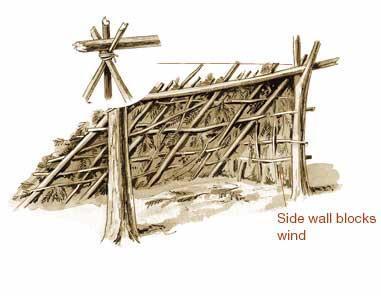 The lean-to shelter is a simple shelter to create. It can be made out of natural materials or man-made materials. Basically, all you need is two base poles, a supporting horizontal pole, and then smaller sticks to create the roof. You can then pack on dead leaves, grass, pine tree boughs or whatever to try and create something that will block out the wind and rain. The roof will act as a reflector for body heat or fire heat. If you couple this shelter with a fire-reflecting wall (see below), it can be quite warm. However, keep in mind, this shelter isn’t wonderful. If the wind shifts it can ruin the whole set-up and turn the shelter into something useless.
The lean-to shelter is a simple shelter to create. It can be made out of natural materials or man-made materials. Basically, all you need is two base poles, a supporting horizontal pole, and then smaller sticks to create the roof. You can then pack on dead leaves, grass, pine tree boughs or whatever to try and create something that will block out the wind and rain. The roof will act as a reflector for body heat or fire heat. If you couple this shelter with a fire-reflecting wall (see below), it can be quite warm. However, keep in mind, this shelter isn’t wonderful. If the wind shifts it can ruin the whole set-up and turn the shelter into something useless. The next shelter I want to talk about is the wedge. Similar to the lean-to, the wedge is very easy to make. It can be made of natural or man-made materials. It’s basically an A-frame type of shelter; one center beam is either lashed to a tree or pole, and then smaller sticks are placed along either side of the beam. You can use tree boughs or other debris, or a tarp to cover either side. This type of shelter will offer more protection than a lean-to, and will reflect more body heat. However, you’re limited on fire placement.
The next shelter I want to talk about is the wedge. Similar to the lean-to, the wedge is very easy to make. It can be made of natural or man-made materials. It’s basically an A-frame type of shelter; one center beam is either lashed to a tree or pole, and then smaller sticks are placed along either side of the beam. You can use tree boughs or other debris, or a tarp to cover either side. This type of shelter will offer more protection than a lean-to, and will reflect more body heat. However, you’re limited on fire placement.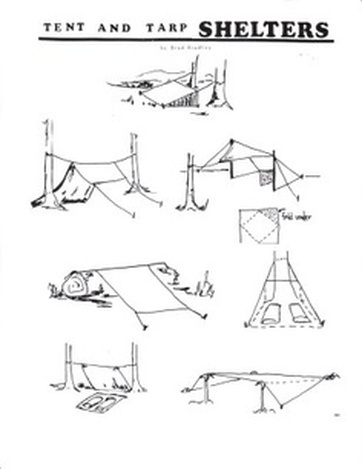 The third shelter I want to talk about the tarp/poncho shelter. If you are going out into the wilderness, carrying a tarp and or a poncho is an invaluable asset. It will keep you dry, you can use it to make a bag or backpack if need be, and they make great shelters. With such an item, the lean-to or the wedge can be created in the same manner, just substitute the branches or boughs with the tarp. The key to the tarp shelter is cordage. You’re going to need something to tie the tarp down. I recommend 550 paracord. It’s light and very strong. Plus, if you need to, you can remove the smaller strings from the inside of the cord for more tying options. I highly recommend taking a poncho with you into the wild. They fold up very small, are lightweight, and can save your life if other shelter-building materials are in low supply.
The third shelter I want to talk about the tarp/poncho shelter. If you are going out into the wilderness, carrying a tarp and or a poncho is an invaluable asset. It will keep you dry, you can use it to make a bag or backpack if need be, and they make great shelters. With such an item, the lean-to or the wedge can be created in the same manner, just substitute the branches or boughs with the tarp. The key to the tarp shelter is cordage. You’re going to need something to tie the tarp down. I recommend 550 paracord. It’s light and very strong. Plus, if you need to, you can remove the smaller strings from the inside of the cord for more tying options. I highly recommend taking a poncho with you into the wild. They fold up very small, are lightweight, and can save your life if other shelter-building materials are in low supply.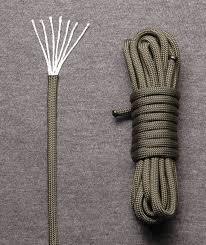
 Finally, I want to address a fire reflector. A fire reflector is a wall of some sort. You can use a natural rock wall, make a wall out of sticks or stones (although be sure the stones are wet or placed far enough away, I’ve read that rocks can explode if heated up enough), or even use an emergency blanket (the silver ones that you always see in the store), just make sure you place the blanket far enough away from the fire so it won’t catch fire. The next step is to angle the reflector. Generally you will angle it 10-20 degrees from straight, and pointing away from your campsite. This will help reflect the heat in the right direction.
Finally, I want to address a fire reflector. A fire reflector is a wall of some sort. You can use a natural rock wall, make a wall out of sticks or stones (although be sure the stones are wet or placed far enough away, I’ve read that rocks can explode if heated up enough), or even use an emergency blanket (the silver ones that you always see in the store), just make sure you place the blanket far enough away from the fire so it won’t catch fire. The next step is to angle the reflector. Generally you will angle it 10-20 degrees from straight, and pointing away from your campsite. This will help reflect the heat in the right direction.Below are some links to a couple of sites that talk about survival shelters in a little more detail. I also recommend practicing these techniques next time you are out camping. Practice makes perfect, and you don’t want to try this out for the first time in an actual survival situation.
Up next, food and water procurement in a survival situation, followed by the will to survive. Remember, there is still time to vote on what you would like to see in the fourth installment.
Go here and vote.
http://crlangille.weebly.com/1/post/2014/02/survival-mini-series.html
Feel free to vote on the other as well, just drop me comment on what that “other” is that you would like to know more about.
http://www.practicalsurvivor.com/shelter
http://www.wilderness-survival.net/shelters-2.php
Published on February 21, 2014 11:38
February 16, 2014
Survival Mini-Series
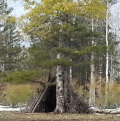 I'm going to be writing a four-part mini-series on survival. Part 1 will be about shelter; how and why. Part 2 will be about food and water. Part 3 will be on the will to survive. That brings me to Part 4. Part 4 will be a bonus post where I'll discuss a few different topics. I want to cover topics that you, the readers, want to know about. Things that perhaps I didn't cover in the first three parts. Please vote below. I just put some topics there to get you started. If there is something you want me to talk about that isn't listed, feel free to put in in the "other" category. I'll pick the three most mentioned topics. You'll have until I'm finished with Part 3 to vote.
I'm going to be writing a four-part mini-series on survival. Part 1 will be about shelter; how and why. Part 2 will be about food and water. Part 3 will be on the will to survive. That brings me to Part 4. Part 4 will be a bonus post where I'll discuss a few different topics. I want to cover topics that you, the readers, want to know about. Things that perhaps I didn't cover in the first three parts. Please vote below. I just put some topics there to get you started. If there is something you want me to talk about that isn't listed, feel free to put in in the "other" category. I'll pick the three most mentioned topics. You'll have until I'm finished with Part 3 to vote.
Published on February 16, 2014 14:03
January 25, 2014
Conflict Part 3
 I want to conclude my conflict mini-series on micro-tension. What is micro-tension? It's the trail of bead crumbs that your readers follow. It's the fish hook that you created that pulls them along the story. If you've done it well, the reader won't even know it.
I want to conclude my conflict mini-series on micro-tension. What is micro-tension? It's the trail of bead crumbs that your readers follow. It's the fish hook that you created that pulls them along the story. If you've done it well, the reader won't even know it.Micro-tension is a combination of a few different things. It could be the change in tone and pace that signals the reader that something is about to happen. They'll want to know what.
It's the unanswered questions that litter the end of your paragraphs, scenes and chapters. Your readers will want to know the answers.
Micro-tension, in other words, is curiosity and desire. You want to leave your readers in a state of needing to know more. If done well, micro-tension will make your story a page-turner.
Here's a small example taken from one of my stories:
I looked at the passenger manifest, twice. Being a sea-faring man, I had my share of superstition. While this didn’t meet any known superstitions I could think of, the fact that Mr. Abernathy was listed on my passenger manifest left me with a sick feeling in my stomach. And that was enough to salt my drinking water.
If I break this down, there are a couple instances found within the paragraph that I would consider examples of micro-tension. Here it is again with some sections colored differently to indicate what I think fit the category.
I looked at the passenger manifest, twice. Being a sea-faring man, I had my share of superstition. While this didn’t meet any known superstitions I could think of, the fact that Mr. Abernathy was listed on my passenger manifest left me with a sick feeling in my stomach. And that was enough to salt my drinking water.
Hopefully, you want to know why Mr. Abernathy vexes the narrator. Why would his inclusion in the voyage be a problem?
I want to take this a step further and show you a short clip. It's from an adaptation of Stephen King's short story, "N." Watch below and then I'll point out some spots that I thought were great uses of micro-tension.
First off, there is a great slow build of tension overall. By the end of the clip, we want to know more. Some specific spots that jumped out to me were, when the narrator talked about spots where reality is thin. As a viewer, I wanted to see an example of this. So, with hopes high, we keep moving forward to hopefully share that example. Another spot, was when he talked about seeing the faces of beasts and monsters in the pillars. This alone is a good use of tension because we want to know more, then they take it a step further and add doubt to the equation by saying it could just be a trick of the light. Now, as a viewer, I want to know which side of the story is real. Are there faces in the pillars? Or is he just going crazy. Micro-tension continues as he introduces the dynamic of numbers and touching and doesn't explain it. Instantly, we need to find out what he's talking about, so we continue. Then, ending it on the possibility that he is diseased and it may be communicable is a great. It's hard to stop on a cliffhanger, so we naturally want to press forward.
That's how your writing needs to be. Don't end chapters with breaks where your characters are going to sleep, or the reader feels like they too can step away from the action. Leave a question unanswered. It doesn't have to be a world-shattering question, just something that the reader will want answered; something that will make them turn to the next page.
Published on January 25, 2014 00:04
January 3, 2014
Conflict Part 2
 Conflict alone won’t raise your book to the best-seller list, the conflict has to be emotionally engaging to the reader. If the story is emotionally engaging, it will generate reader interest. Your goal as an author is to create emotional familiarity within your work.
Conflict alone won’t raise your book to the best-seller list, the conflict has to be emotionally engaging to the reader. If the story is emotionally engaging, it will generate reader interest. Your goal as an author is to create emotional familiarity within your work. You might ask me, "Well, my book is a far-future, space opera, based on the life of a highly advanced form of life. How do I write something familiar with that?" While it may be difficult to imagine, writing something emotionally familiar isn't hard to do. You may already be doing it. You can write your space opera, epic fantasy, or historical fiction, but the emotional content needs to be relateable to the reader. Anger, happiness, sadness, euphoria, depression... these are all familiar emotions. They are universal and cross culture boundaries. That being said, they can cross genre boundaries just as easily. Karl Iglesias said, “Bottom line, it doesn’t matter who or what you write about as long as your characters experience emotions we understand and relate to.” What does this mean?
Coming up next: Conflict Part 3--Micro-tension.
Published on January 03, 2014 18:18



